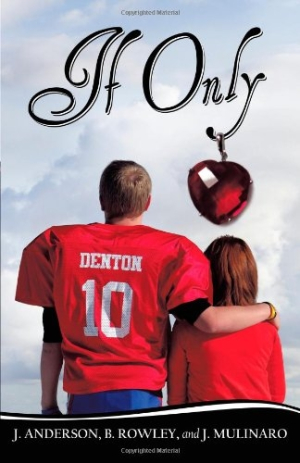If Only
Respectful, sweet characters combine with rich detail of day-to-day life to present a worthwhile message about love.
In If Only, a sweet romance about first love, star high school quarterback Bill and pretty redhead Sarah have an instant attraction—but his football career and lack of confidence with girls complicates the relationship. It takes forty years for them to finally make a commitment.
On the back cover of the book, authors J. Anderson, B. Rowley, and J. Mulinaro describe the novel as a fictionalized account of real events, a reimagining of what could have been, which adds a level of intrigue about which elements are “true.”
Set in Indianapolis, the story starts forty-five years after Bill and Sarah first meet. They are on the verge of finally starting their life together, and the relationship is told in flashback. A summary of the entire narrative is given in the first chapter, though, which doesn’t leave room for plot progression in the lengthy novel. While the authors include a lot of descriptive details that help paint full pictures of the scenes, the lack of a story arc makes it difficult to sustain interest through the minutiae presented for the ordinary events—high school football games, friends studying together, dinner dates.
Still, the characters are all pleasant. They’re respectful, churchgoing people, in the Christian fiction tradition. There is nothing unlikable about them and certain aspects make them quite sympathetic and could draw readers in emotionally, particularly the fact that Bill lost his parents in a car accident when he was ten and has essentially been raising himself since. However, because the characters don’t have any flaws, readers are likely to find them difficult to relate to.
The characters’ dialogue is also very formal. For example, when Bill’s coach asks him why he got into a fistfight with another student, Bill says: “There is a strong reason for my actions but I must maintain my silence sir.” As a result, the teen characters come across as much older than they are. They also sound very similar to each other. Talking to Bill about a note he sent her, Sarah says: “Your words were so warm and touched my very soul.” When Sarah and Bill both begin dating other people, Bill’s new girlfriend, Maddie, the star cheerleader at the high school, adopts the same tone, too. When he tells her about his parents’ death, Maddie asks: “With whom do you live?” The interactions don’t sound authentic.
Several scenes are repeated among different characters and the pace slows through a large part of the narrative. Overall, there isn’t enough dramatic conflict to fully engage readers, and the premise for the conflict that does exist—that Bill is afraid to tell Sarah he loves her—doesn’t ring true because early on in their relationship they both explicitly express their feelings to each other. Ultimately, there is no plausible reason keeping Sarah and Bill apart for so long.
There is a surprising revelation at the conclusion, though, with a poignant and worthwhile message. If the characters were more realistic, readers would be more emotionally invested at that point and the resulting cautionary warning offered by the authors would have a stronger impact.
Reviewed by
Maria Siano
Disclosure: This article is not an endorsement, but a review. The publisher of this book provided free copies of the book and paid a small fee to have their book reviewed by a professional reviewer. Foreword Reviews and Clarion Reviews make no guarantee that the publisher will receive a positive review. Foreword Magazine, Inc. is disclosing this in accordance with the Federal Trade Commission’s 16 CFR, Part 255.

